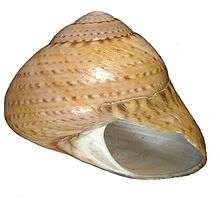Oxystele impervia
Oxystele impervia is a species of sea snail, a marine gastropod mollusk in the family Trochidae, the top snails.[1]
| Oxystele impervia | |
|---|---|
 | |
| Oxystele impervia | |
| Scientific classification | |
| Kingdom: | Animalia |
| Phylum: | Mollusca |
| Class: | Gastropoda |
| Clade: | Vetigastropoda |
| Order: | Trochida |
| Superfamily: | Trochoidea |
| Family: | Trochidae |
| Genus: | Oxystele |
| Species: | O. impervia |
| Binomial name | |
| Oxystele impervia (Menke, 1843) | |
| Synonyms[1] | |
| |
Description
The size of the shell varies between 12 mm and 18 mm. The imperforate, rather thin shell has a conoidal shape. Its ground color is (usually) whitish, pinkish or bluish, painted with red, brown or blackish in innumerable patterns, but usually in one of the following modes :
- longitudinal zigzag dark stripes on a light clear ground
- very obliquely descending narrow stripes or lines, generally zigzag or interrupted about the middle of the whorl
- narrow spiral articulated bands around the middle of the whorl, the base mottled or barred, and the suture bordered by a row of dark blotches
- ground-color pink or purplish, the entire surface variegated by rather narrow spiral bands, finely articulated with red or purple and white
The elevated spire is conical. The sutures are distinctly impressed. The apex is minute and acute when not eroded. The 6 whorls are convex, quite smooth outside, but when eroded the nacre is seen to be finely spirally lirate. The base of the shell is not eroded. The aperture is very oblique. The acute outer lip is narrowly margined, iridescent within, the nacre smooth, but apparently lirate. The white, thin columella is arcuate, concave. It covers the place of the umbilicus with a pad of callus, the outer edge of which is usually not appressed closely to the base. The parietal wall contains a thin translucent callus or none. The umbilico-columellar callus is bounded outside by a more or less obvious streak of blue, green, brown, or sometimes light yellowish.[2]
Distribution
This marine species occurs off the southern Atlantic coast of South Africa.
References
- Oxystele impervia (Menke, 1843). Retrieved through: World Register of Marine Species on 10 July 2012.
- Tryon (1889), Manual of Conchology XI, Academy of Natural Sciences, Philadelphia (described as Monodonta sagittifera )
- Steyn, D.G. & Lussi, M. (1998) Marine Shells of South Africa. An Illustrated Collector’s Guide to Beached Shells. Ekogilde Publishers, Hartebeespoort, South Africa, ii + 264 pp. page(s): 24
- Branch, G.M. et al. (2002). Two Oceans. 5th impression. David Philip, Cate Town & Johannesburg.
- Donald K.M., Kennedy M. & Spencer H.G. (2005) The phylogeny and taxonomy of austral monodontine topshells (Mollusca: Gastropoda: Trochidae), inferred from DNA sequences. Molecular Phylogenetics and Evolution 37: 474–483.
External links
| Wikimedia Commons has media related to Oxystele impervia. |